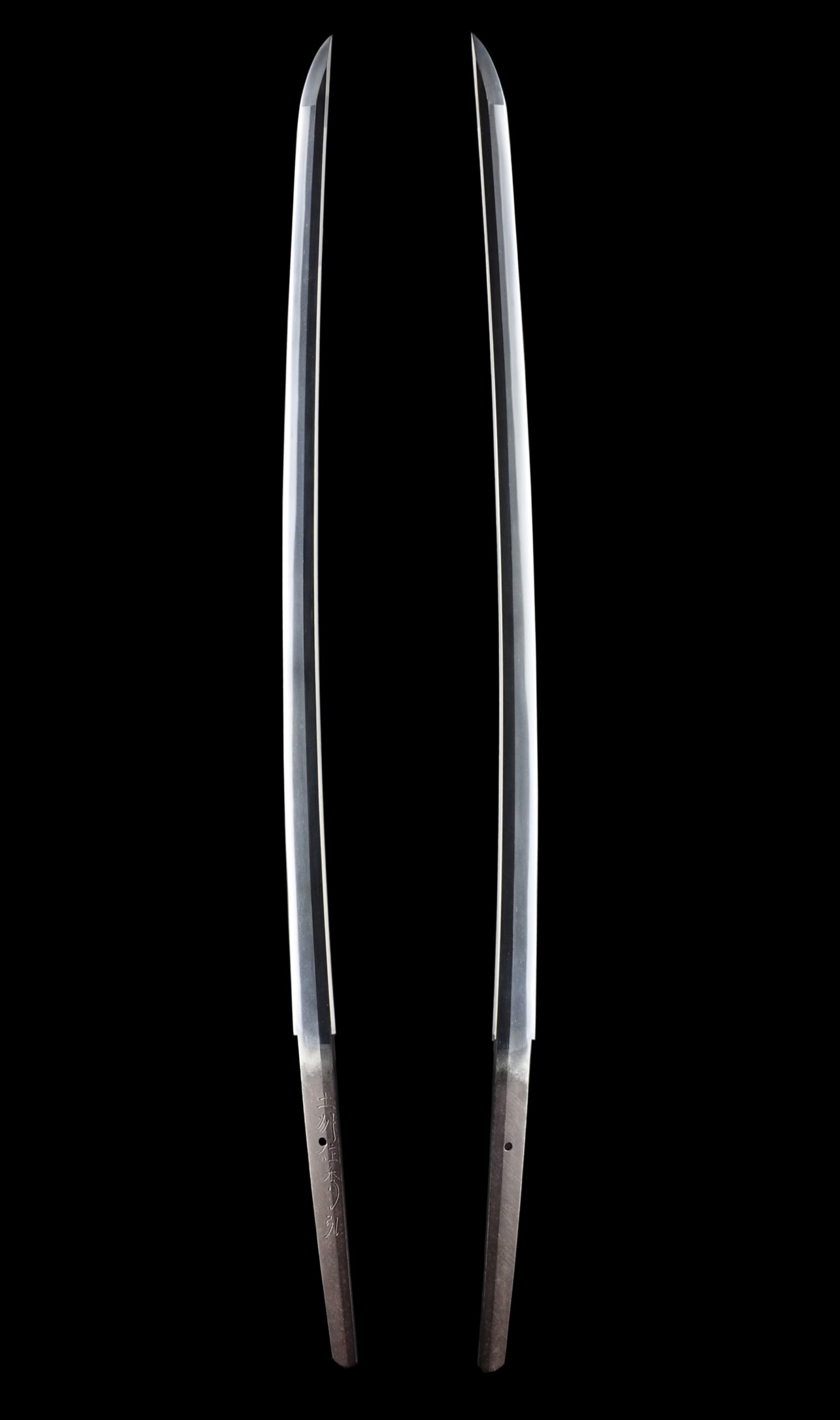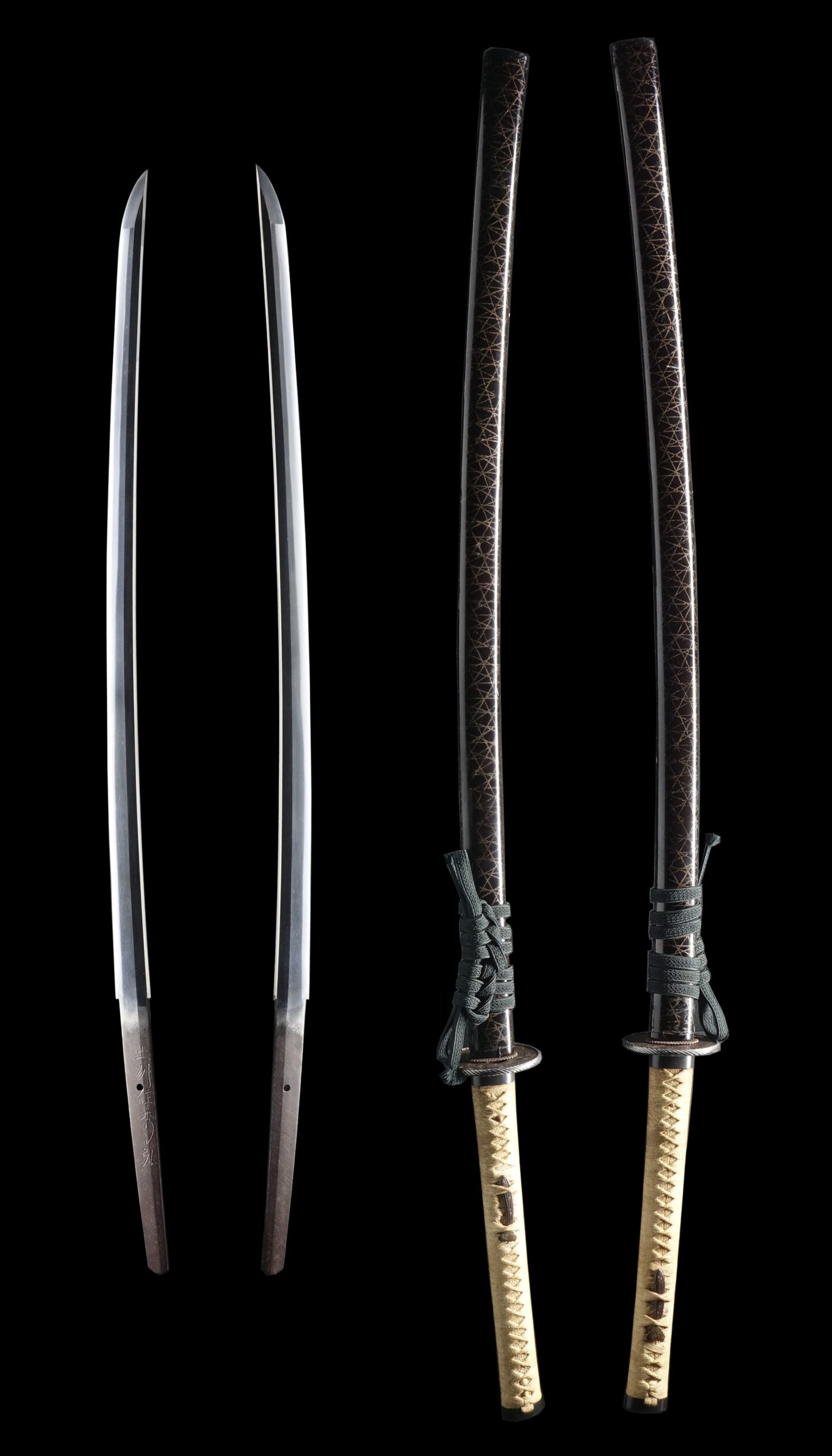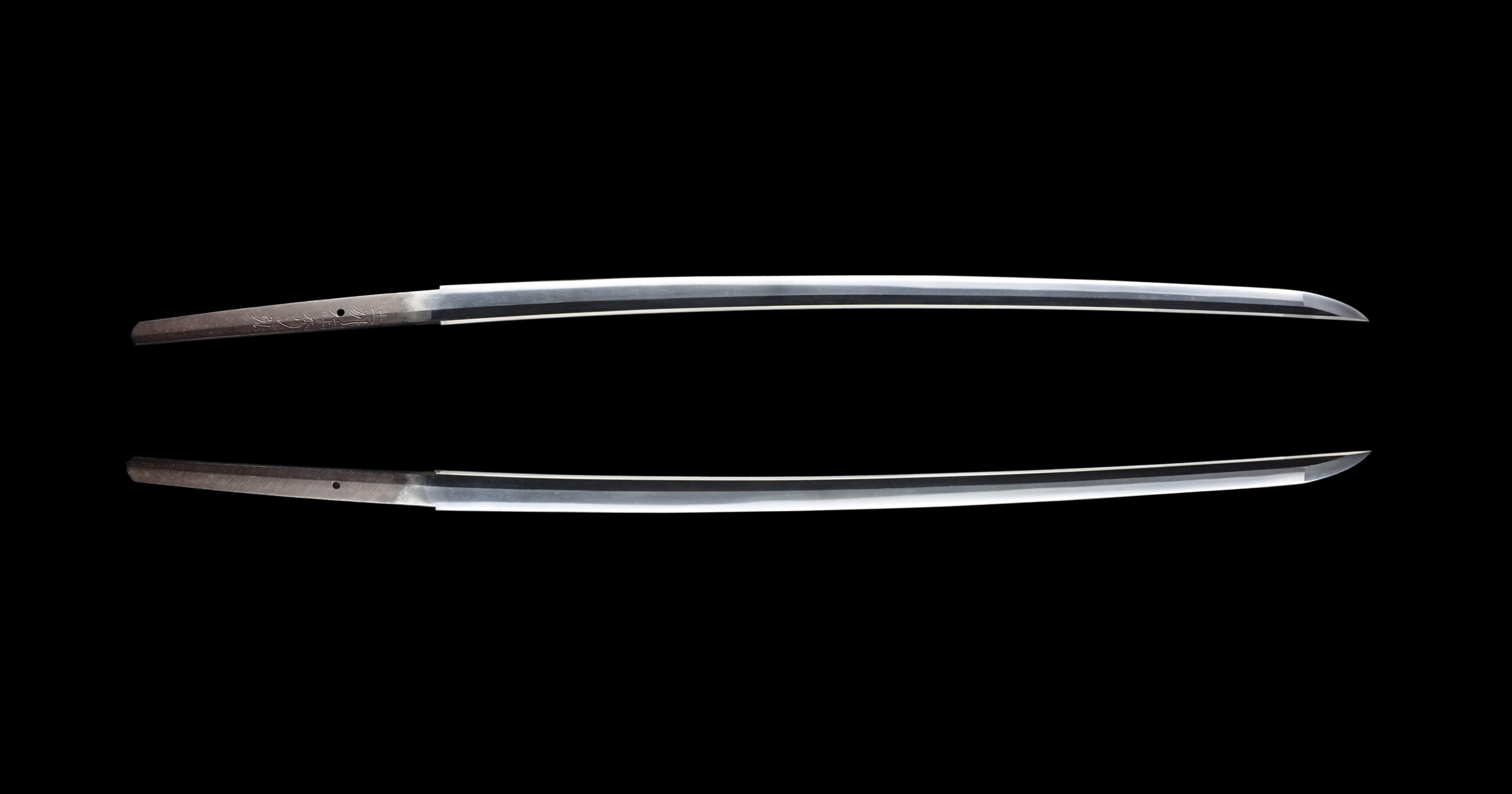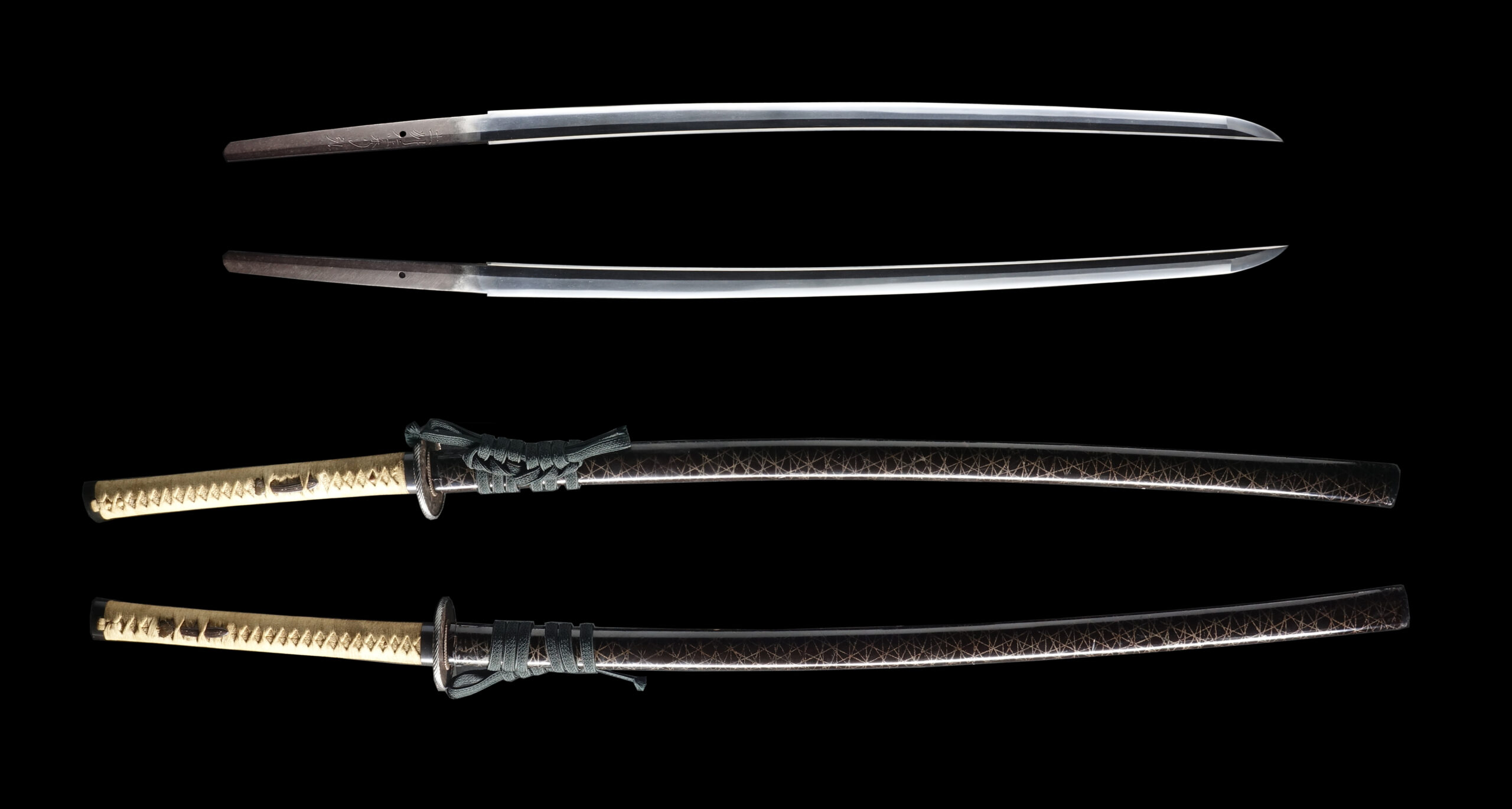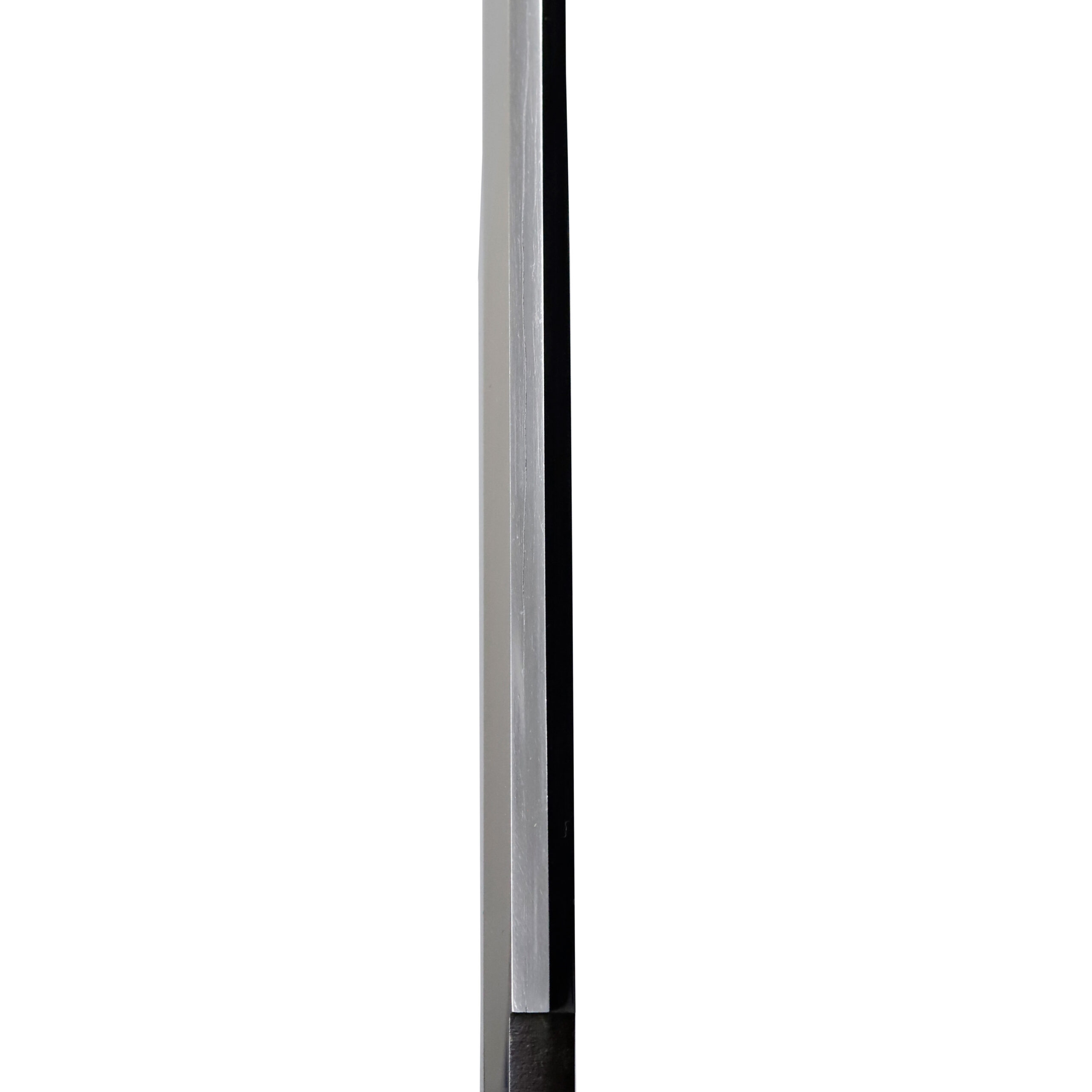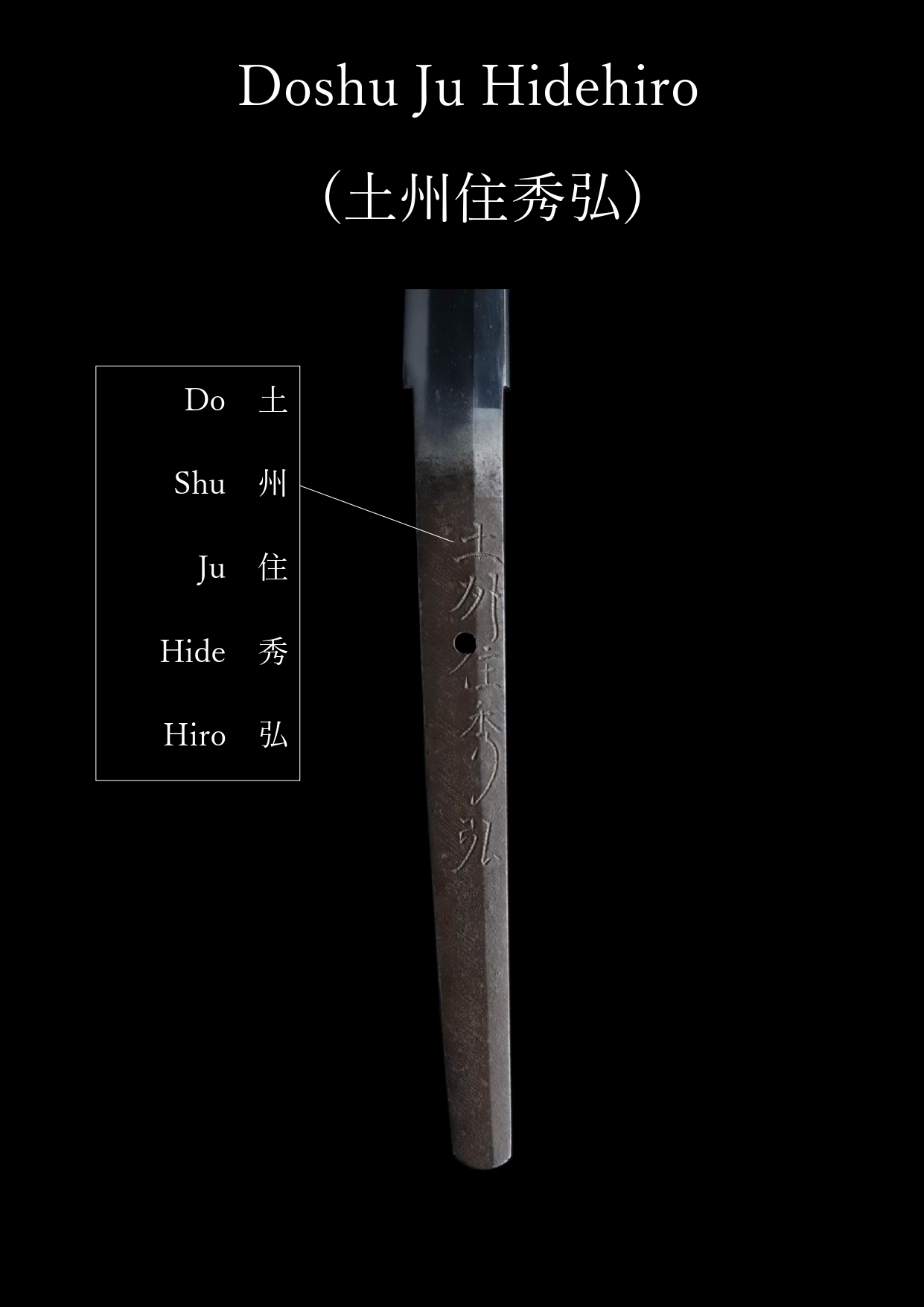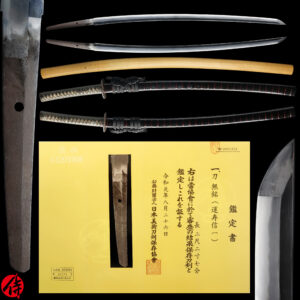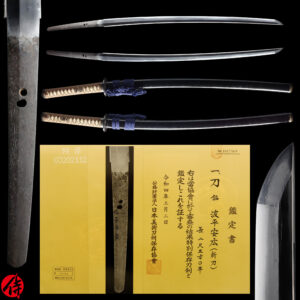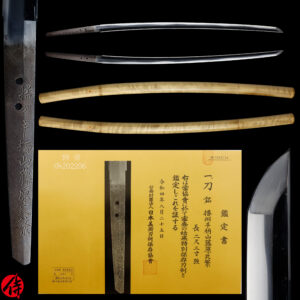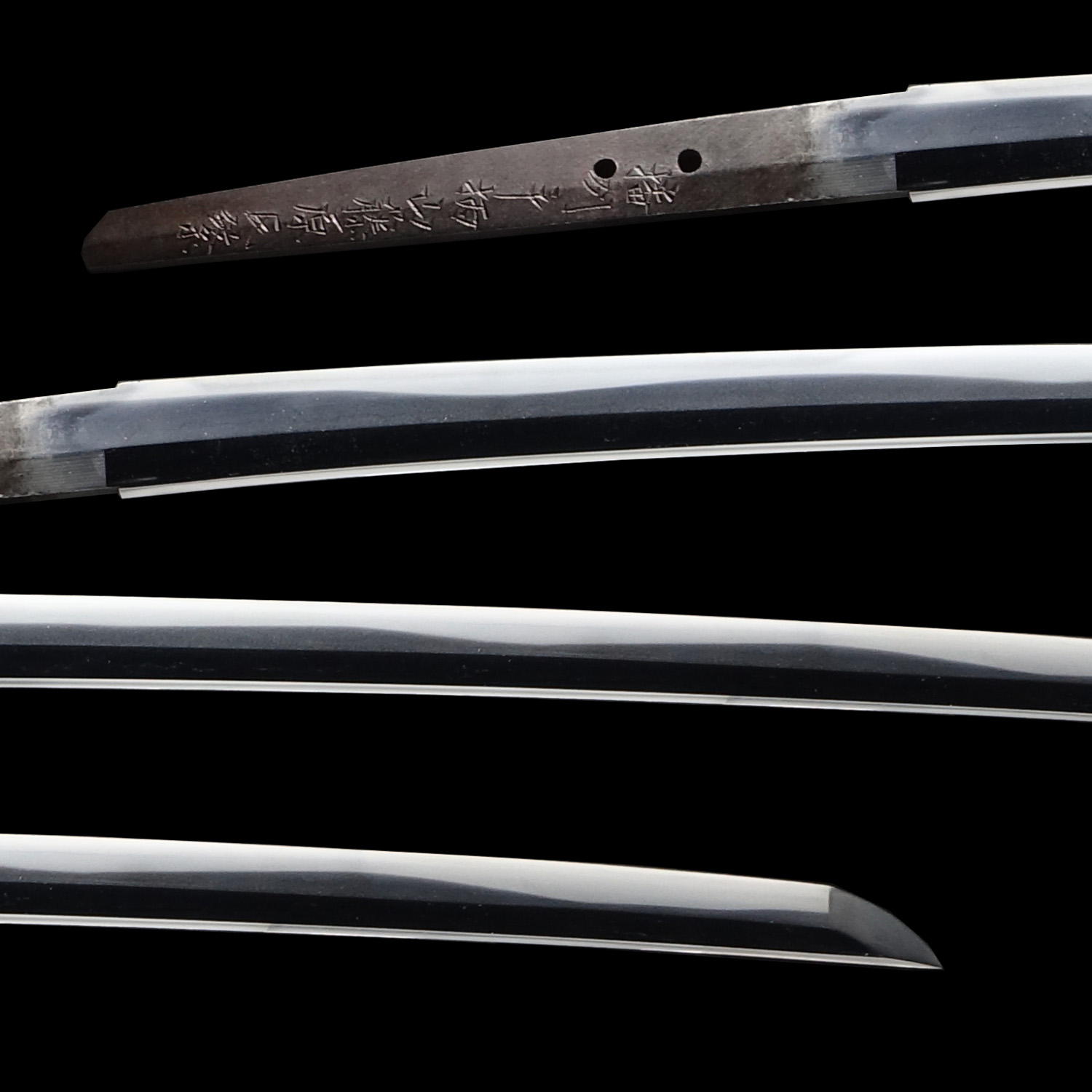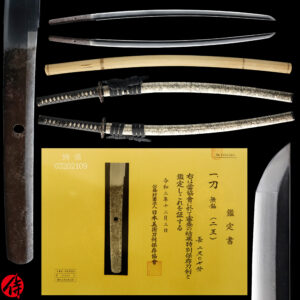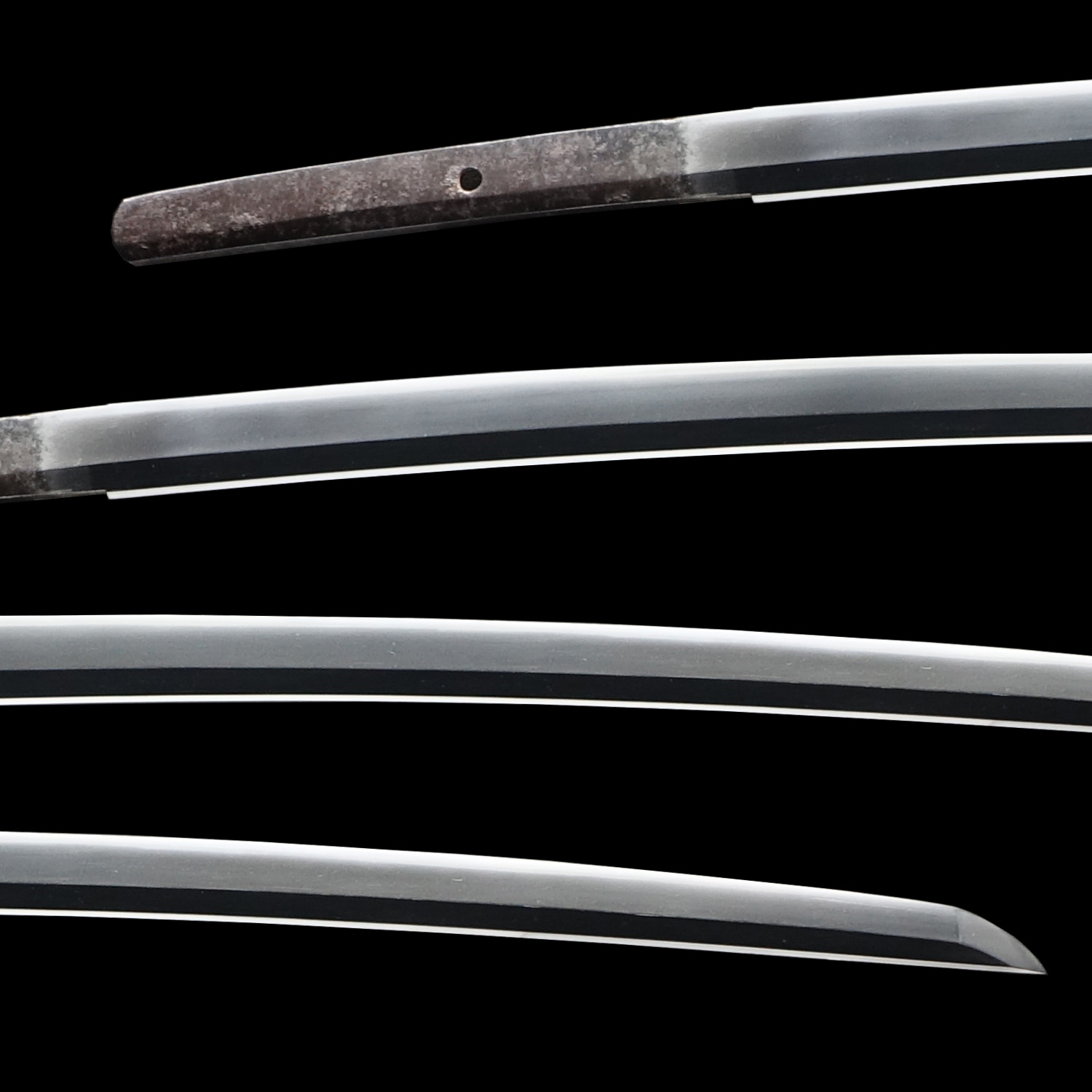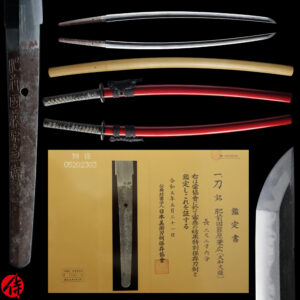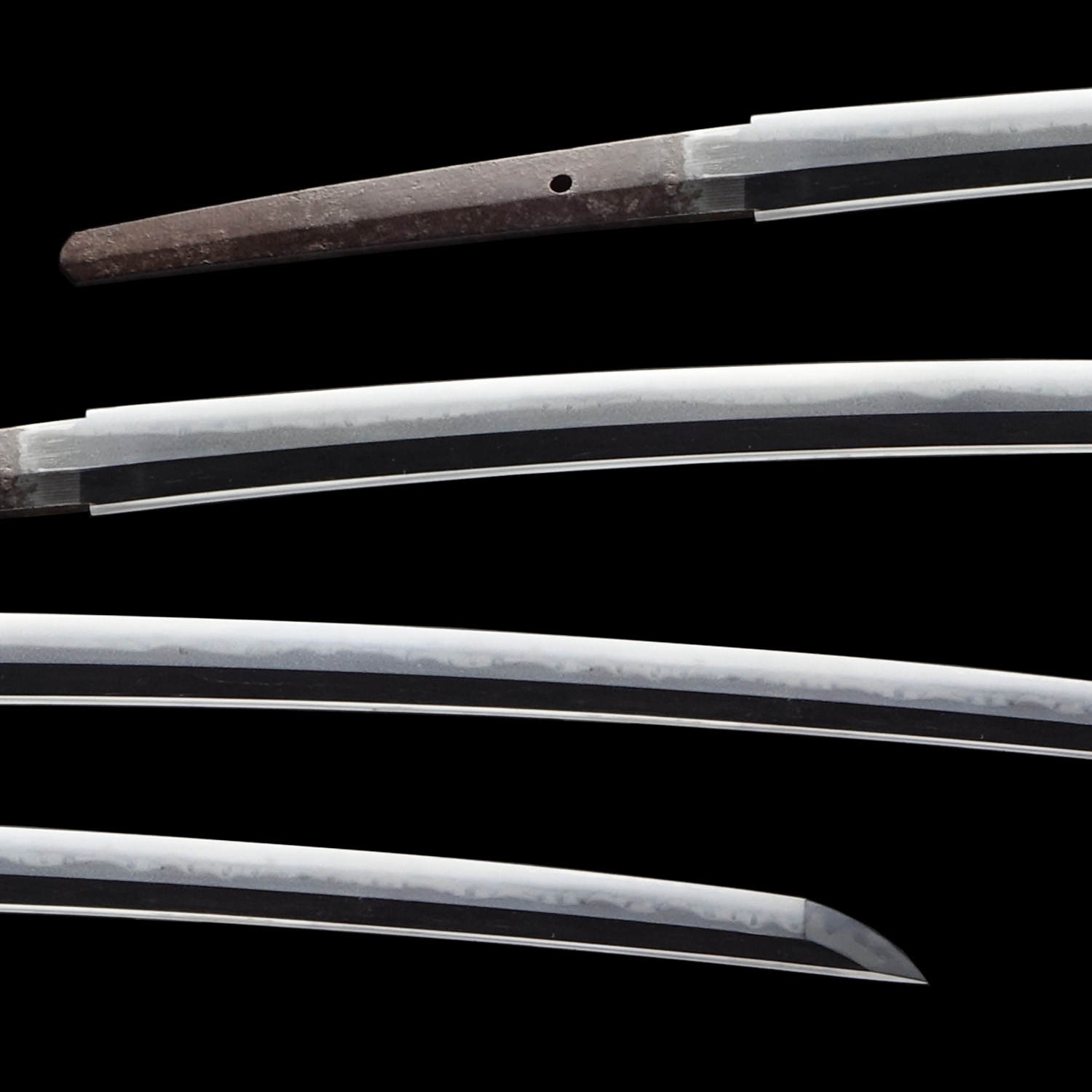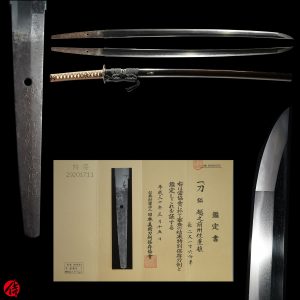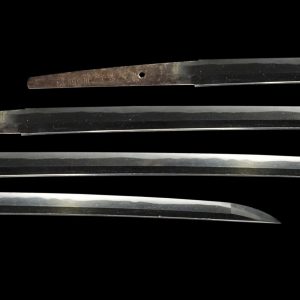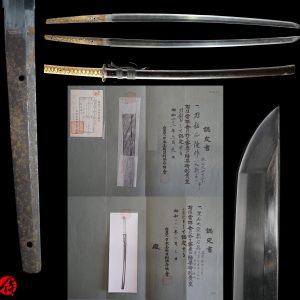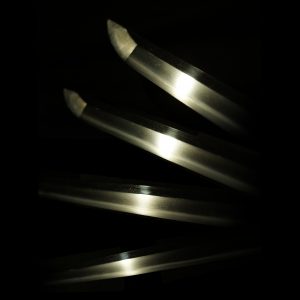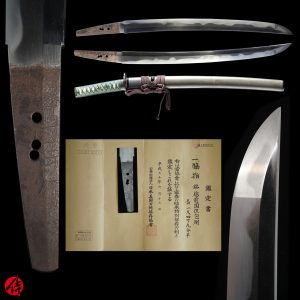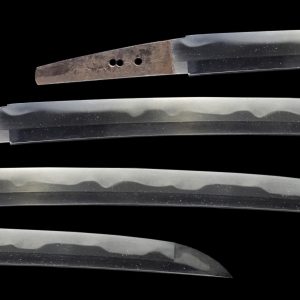Antique Japanese Sword Katana Signed by Doshu Hidehiro with Tokubetsu Hozon Certificate
【Description】
Summary
This blade was signed by Doshu Jyu Hidehiro (土州住秀弘) during the Keio era (1865-1868: The end of the Edo period). Doshu is another name for Tosa province, located in today’s Kochi prefecture. He was a student of Sano Yukihide (左行秀). Hidehiro served the Yamauchi family and dedicated his creations to Tosa Shrine, Yasukuni Shrine, and other prominent shrines. He was especially active during 1861-1868 (The end of the Edo period). Yamauchi family was one of the most influential families in Tosa province during the Edo period.
One of Hidehiro’s swords was owned by Miyakawa Sukegoro, a member of bodyguards for Yamauchi Yodo, the 15th head of Tosa domain. It is said that a sword made by Hidehiro was used in a conflict between this bodyguard group and Shinsengumi, a military unit organized by Tokugawa Shogunate. According to available records, Miyakawa Sukegoro was able to kill a couple of members of Shinsengumi in this incident. Since then, Hidehiro became famous for forging extremely sharp blades.
His master, Sa Yukihide, was a renowned swordsmith in Tosa province. It is said that Hidehiro regularly did Daisaku for Yukihide. Daisaku is a regular act where an apprentice or a child of the swordsmith signs his master’s name with his master’s permission or forges a blade on behalf of the master. That means that his master highly acknowledged Hidehiro’s craftsmanship. Considering the fact that Hidehiro did Daisaku for Yukuhide, they must have had a very close relationship and trusted each other.
Sano Yukihide (His Master)
Yukihide was born in the 10th year of the Bunka era (1813) as the second son of Ito Gozaemon in Chikuzen province (Today’s Fukuoka prefecture). He first signed Nobukuni (信国) and changed it to Yukihide (行秀). He was an offspring of a member of Chikuzen Samonji school, one of the most prestigious schools during the Nanbokucho period in the region. He called himself the 39th-gen offspring of Samonji.
During the Tenpo era (1831-1845), he moved to Edo city. He became an apprentice of Shimizu Hisayoshi, who studied under Hosokawa Masayoshi, one of the most famous swordsmiths at the end of the Edo period. One of the earliest works signed by Yukihide is from the 11th year of the Tenpo era (1840). After finishing his apprenticeship, he went to Tosa province (Today’s Kouchi prefecture) in 1846 and learned sword-forging techniques from Sekita Katsuhiro. His master died in 1855, and in the following year, Yukihide was appointed as an Okakaekaji for Tosa province. Okakaekaji is a swordsmith who exclusively forged swords for a specific clan or domain. His craftmanship was highly acknowledged, and he was able to receive this honor. He is categorized as a top-tier swordsmith who was active at the end of the Edo period.
Background
Japan enjoyed a relatively peaceful time from the early Edo period to the mid-Edo period(the 1600s-1760s) because of the stable economy and the powerful government run by Tokugawa Shogun. Samurai didn’t have many opportunities to utilize his Katana sword in public or on battlefields during this time. Thus, they carried their swords more as a symbol of their social status. The demand for weapons decreased accordingly compared to the previous Warring state period called Sengoku Jidai (1467-1600).
However, toward the end of the Edo period(1764-1876), the Japanese sword’s role changed dramatically. With the poverty spreading in Japan, there were so many riots initiated by the civilians. Japanese sword started to play an essential role in maintaining public safety.
Pressure from foreign countries to open Japanese borders also forced Samurai to order strong-looking swords to survive this tumultuous time. We believe many swordsmiths, including Hidehiro, made great efforts to forged high-quality, practical blades for their masters to prepare for battles.
There was a civil war between Tokugawa’s military government and the new Meiji government at the end of the Edo period. That means the original owner of this Katana might have seen the moment when Samurai’s life changed forever. This blade has a strong looking and must have been practical to use in that demanding time.
It is appraised as a Tokubetsu Hozon Token(特別保存刀剣) issued by NBTHK(Nihon Bijutsu Touken Hozon Kyokai:日本美術刀剣保存協会). This authentication paper was only given to authentic Japanese swords, especially well preserved and high quality with artistic value.
【 Blade】
Cutting Edge Length(Nagasa): 74.8 cm (29.4 inches)
Curvature(Sori):1.0 cm (0.39 inches)

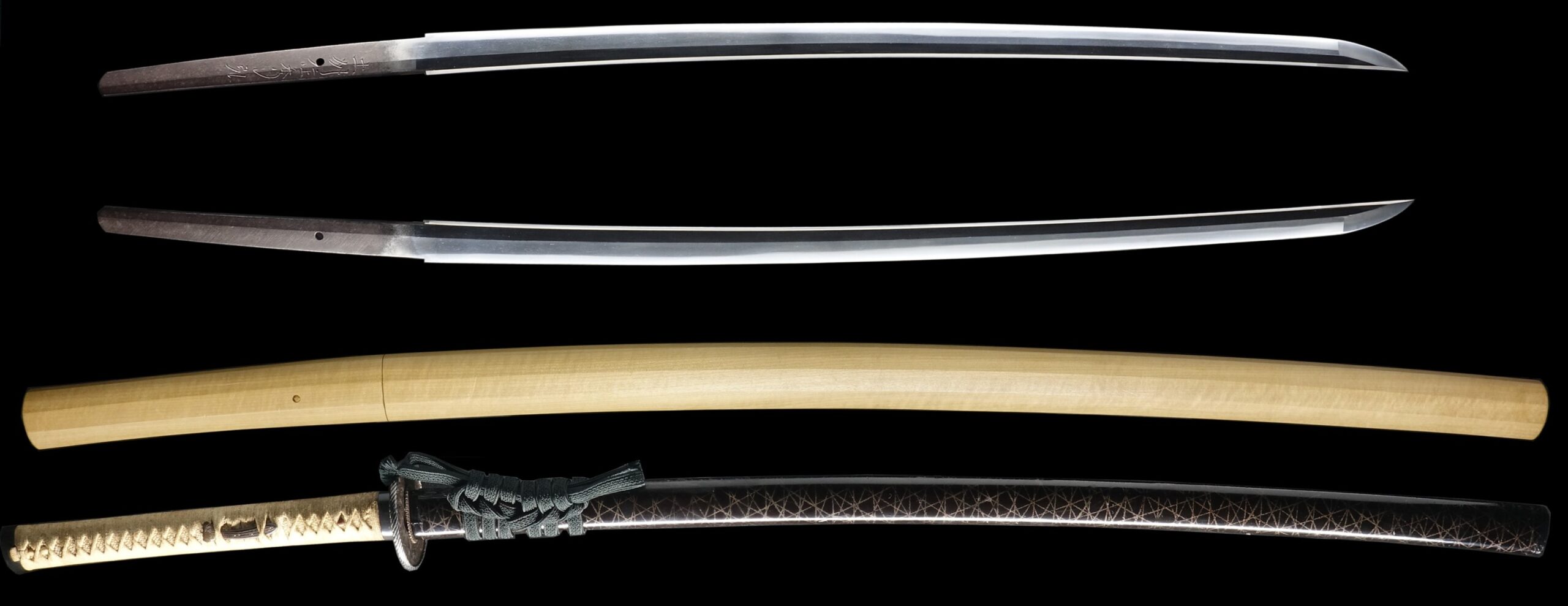
Hamon:
The crystalline structure which forms along the cutting edge of a blade as a result of the hardening process
Jimon(Jihada):
visible steel surface pattern created by folding and hammering during forging process
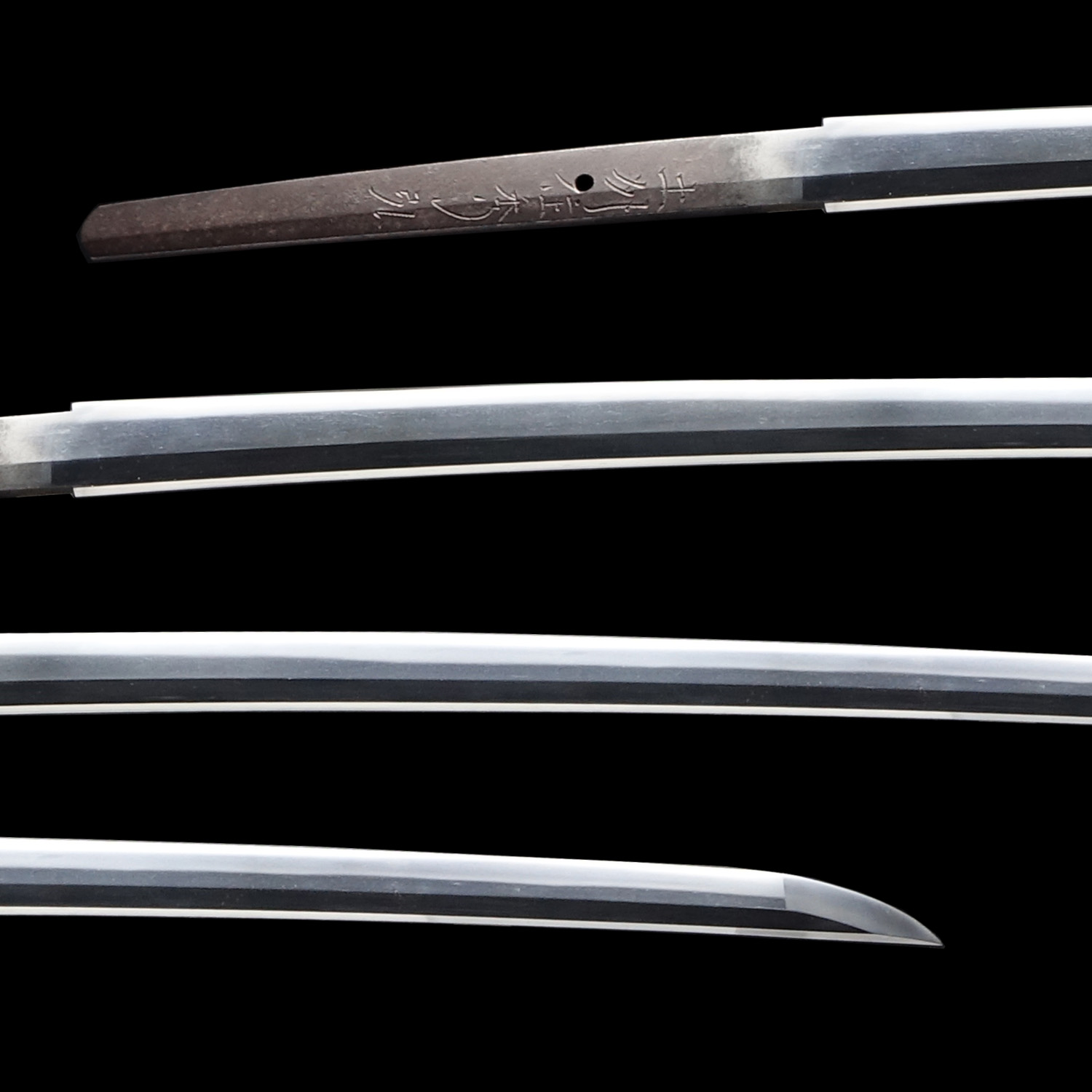
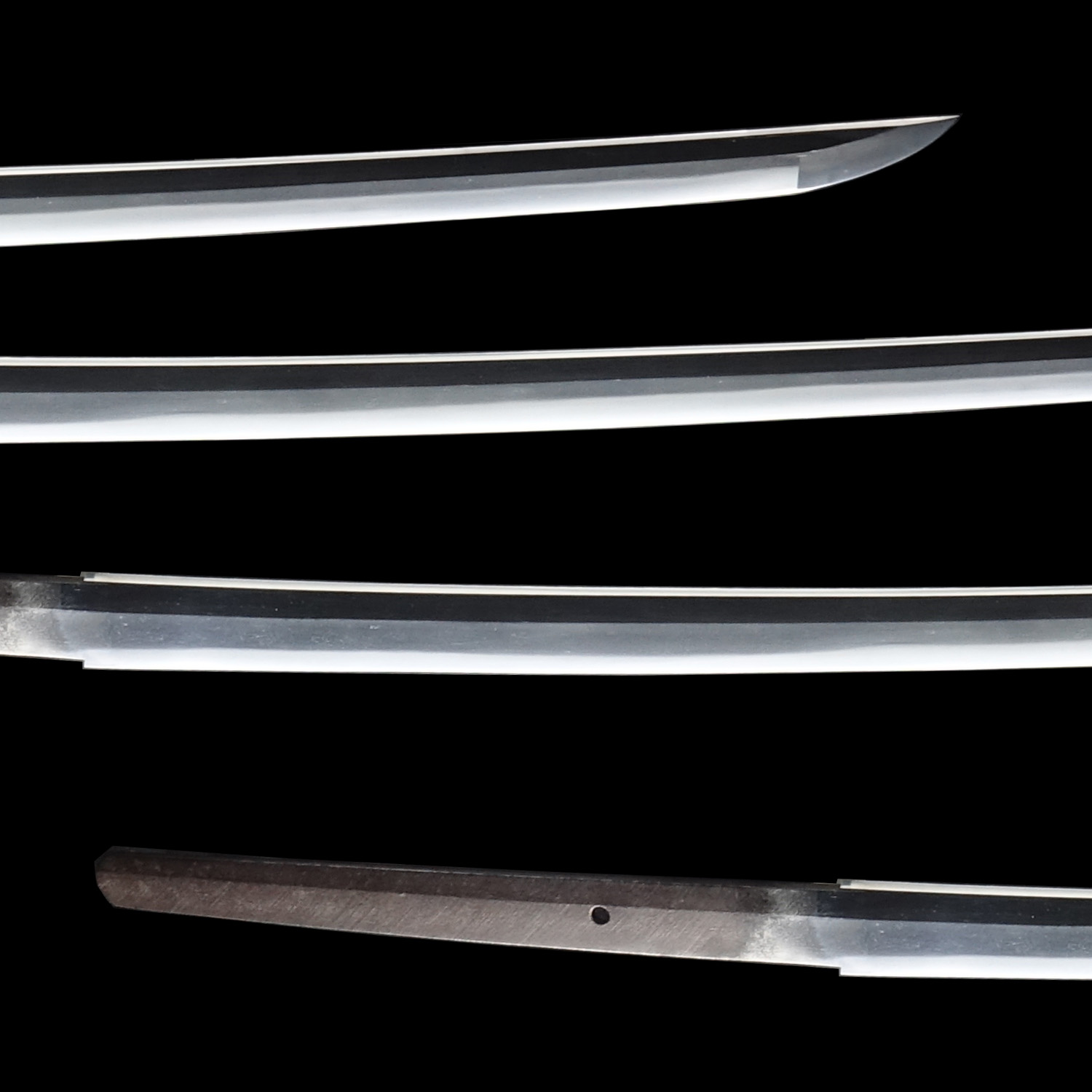
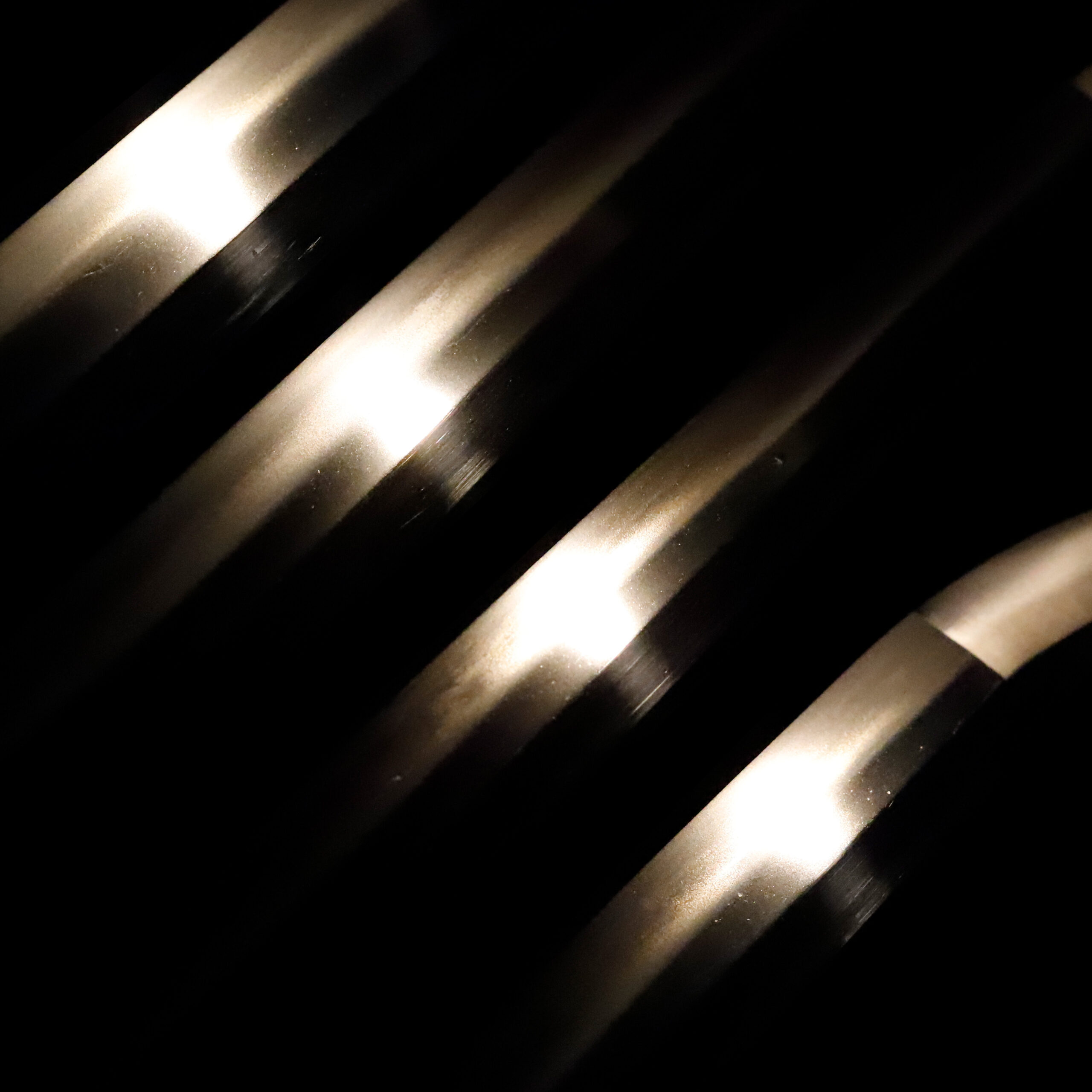
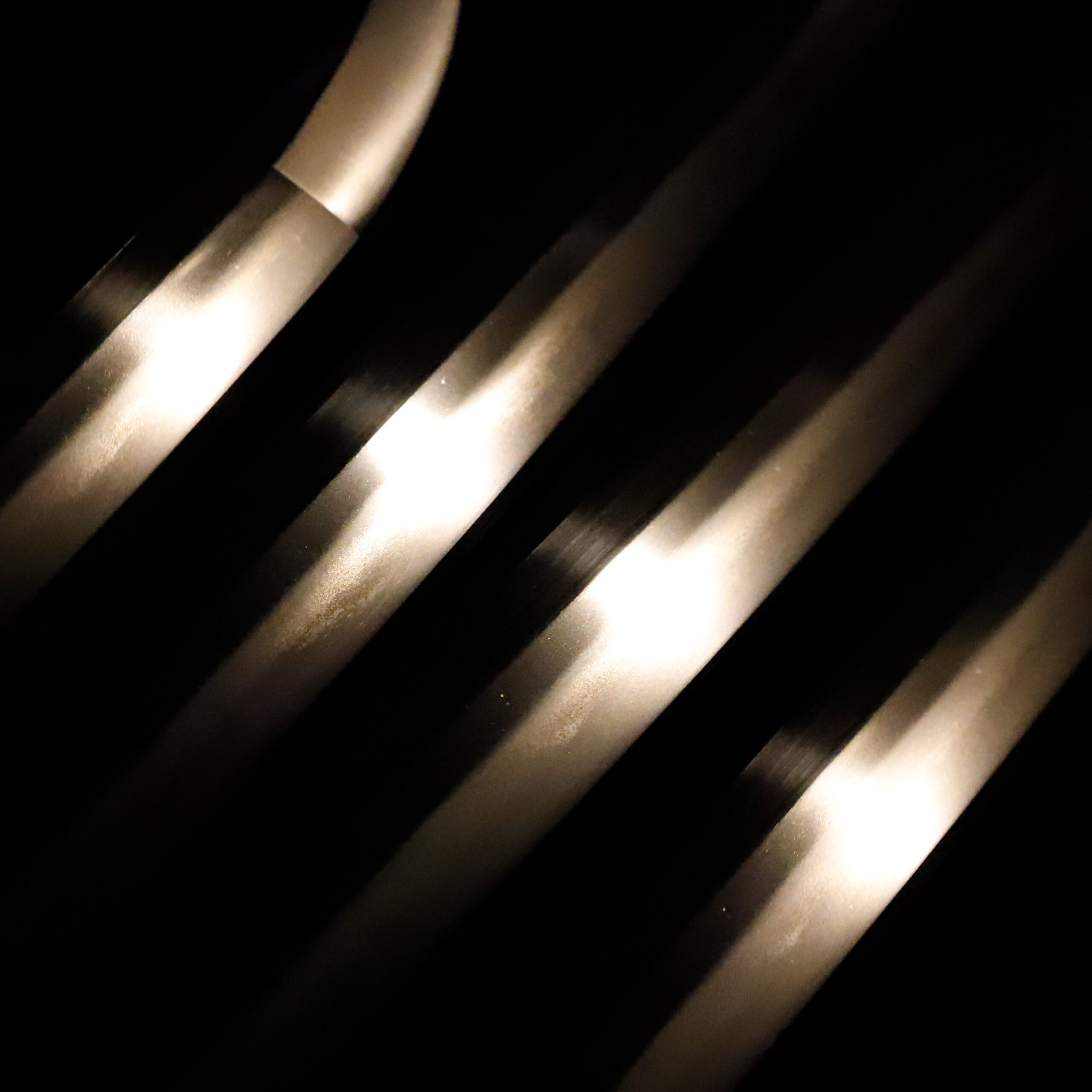
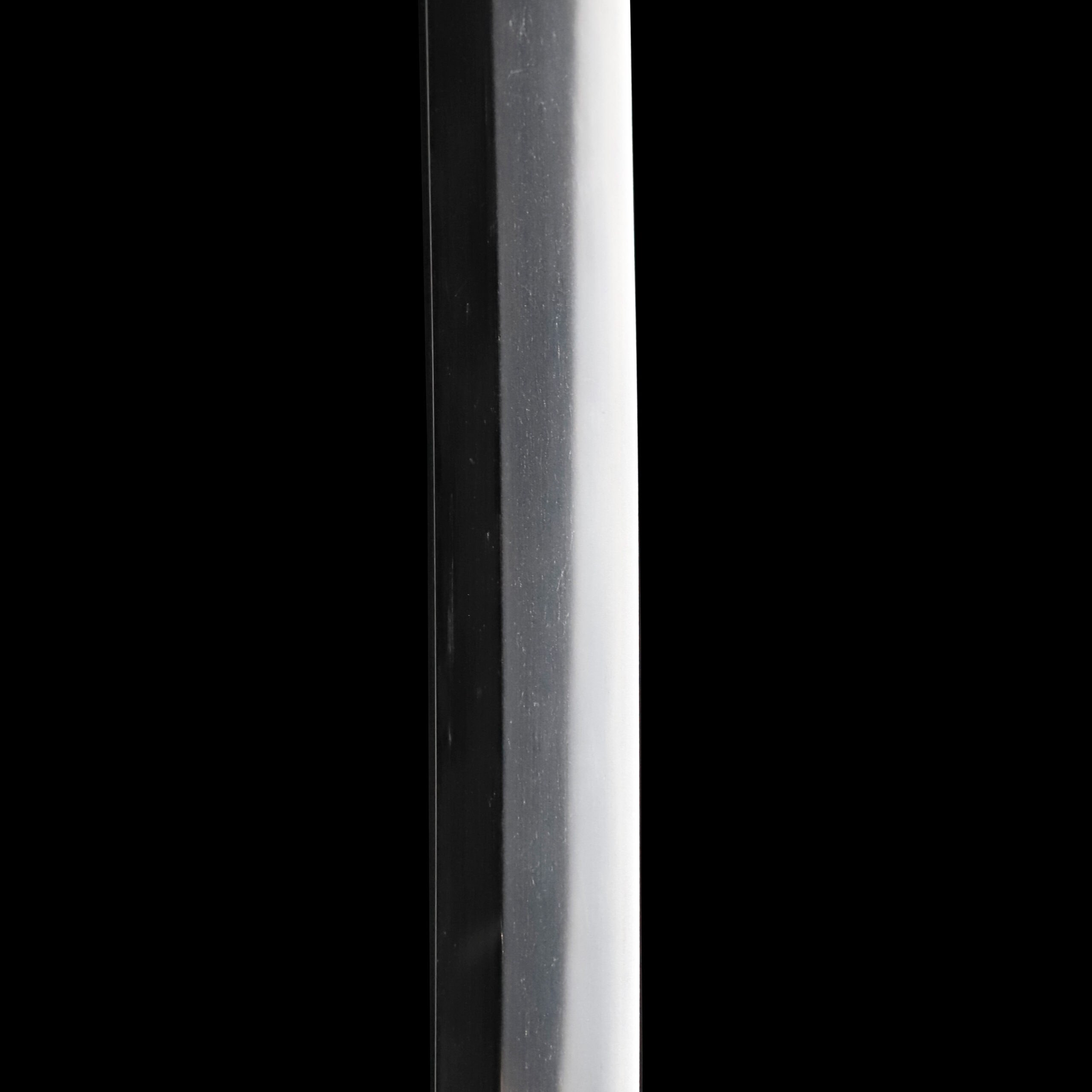
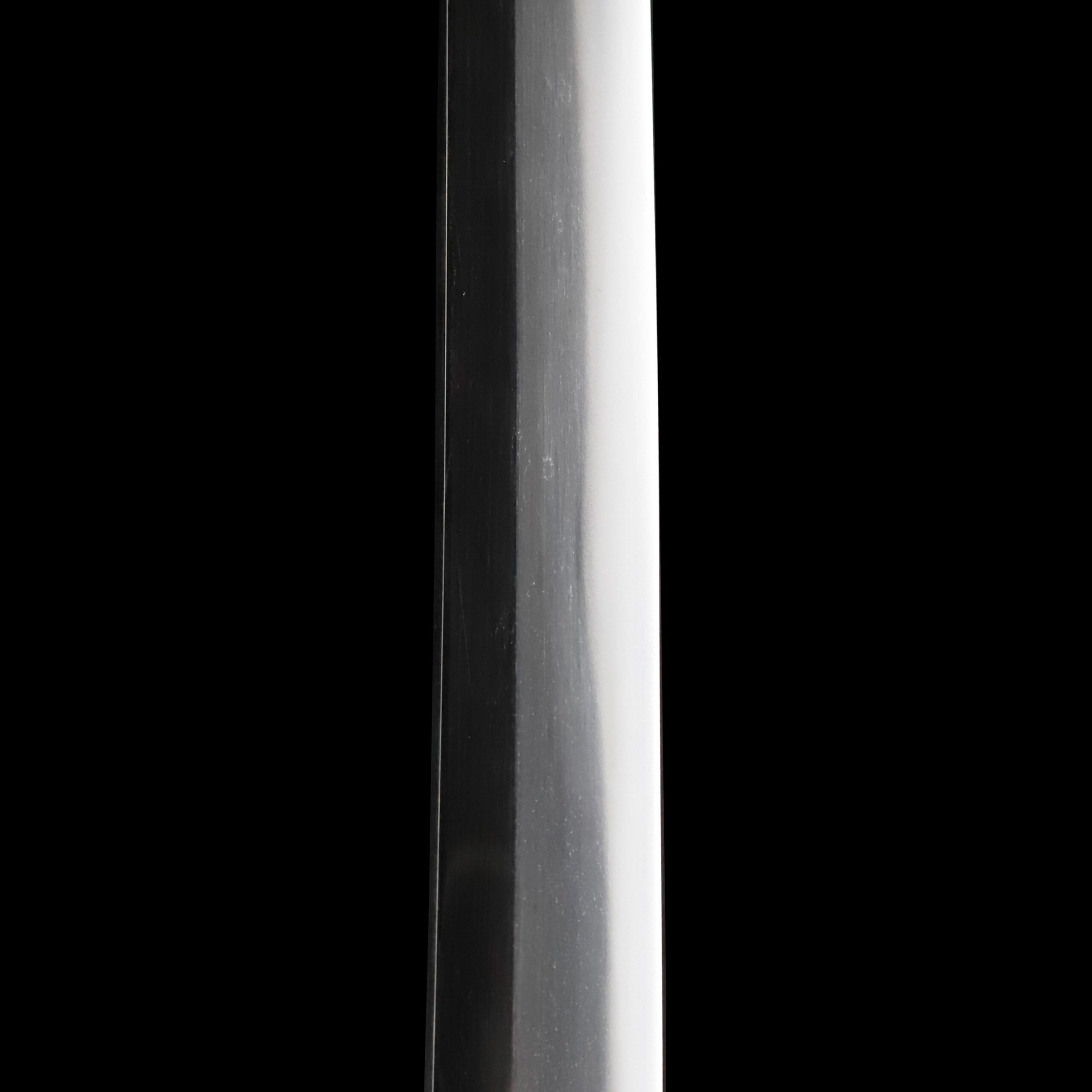
Nakago:Nakago is the tang of the Japanese sword.
Japanese swordsmiths left the black rust on the tang because it prevents red rust while the tang is in its handle. And the discoloration of the tang was created over time, and it is a great indicator for a Japanese sword specialist to estimate when the sword was forged.
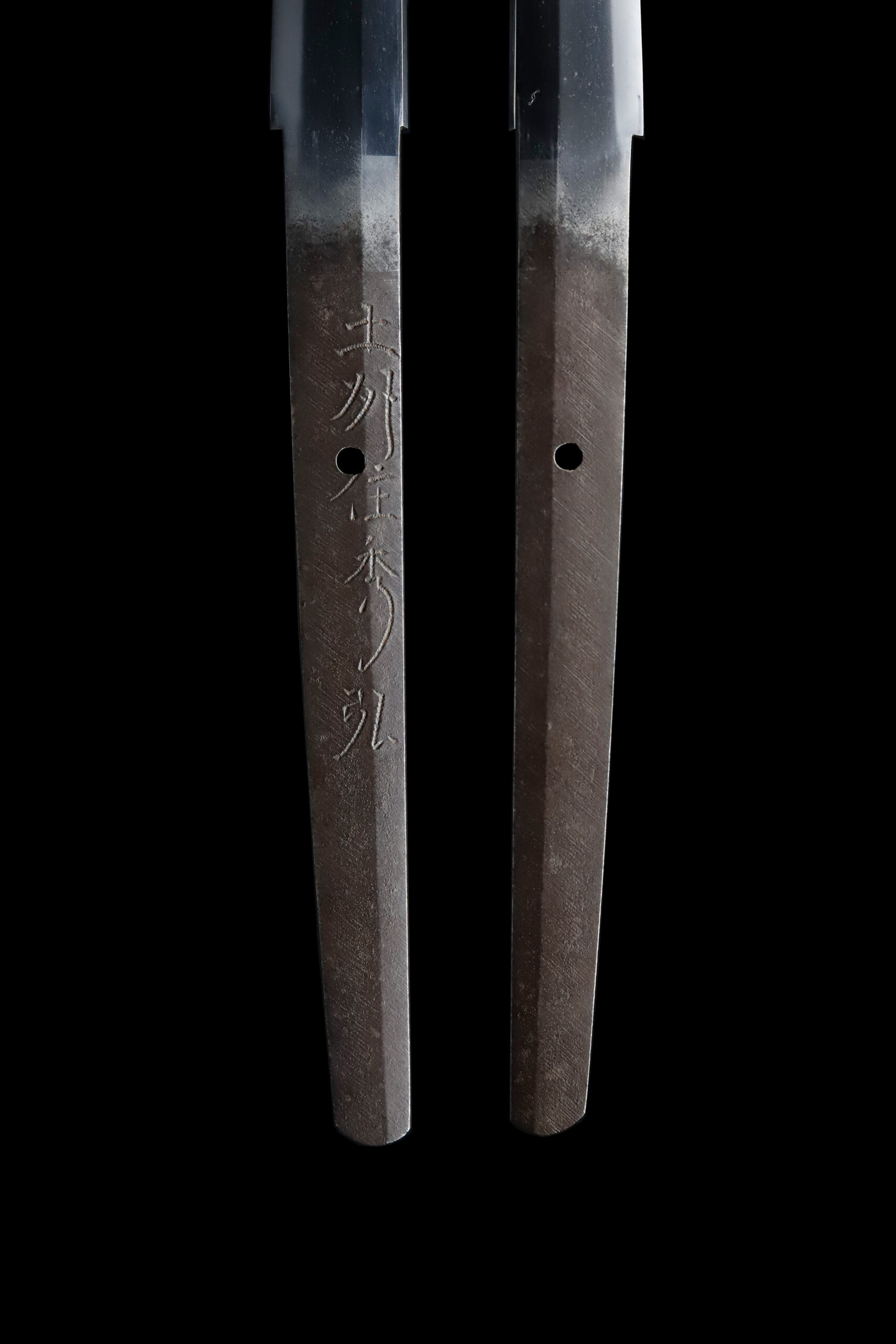
Koshirae: Koshirae is the mounting of the Japanese sword. There are several parts that consist of Koshirae such as Saya(Scabbard), Tsuka(Handle), Tsuba(Handguard).
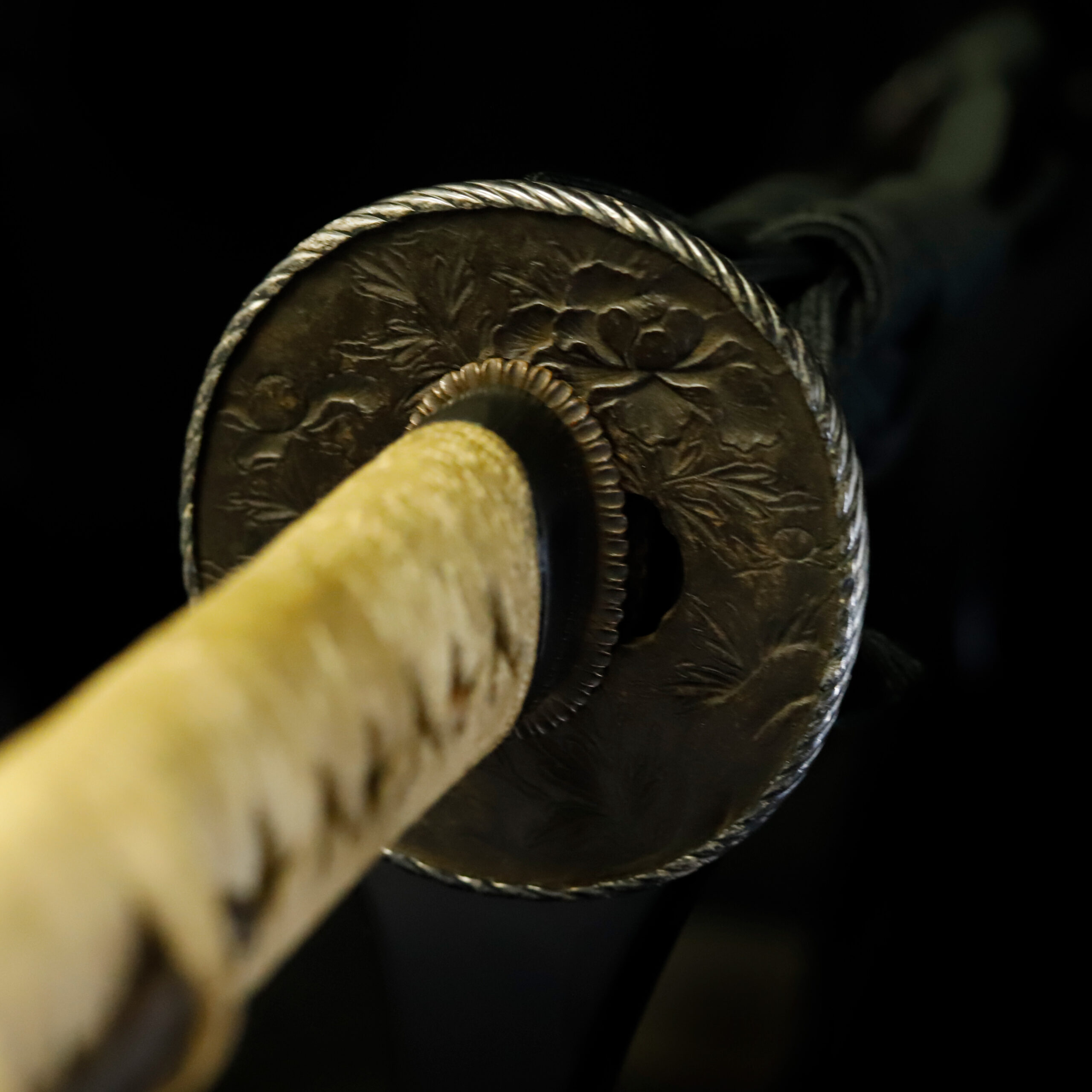
Fuchi-Kashira:A pair of matching sword fittings that cover the upper and bottom parts of its sword hilt.
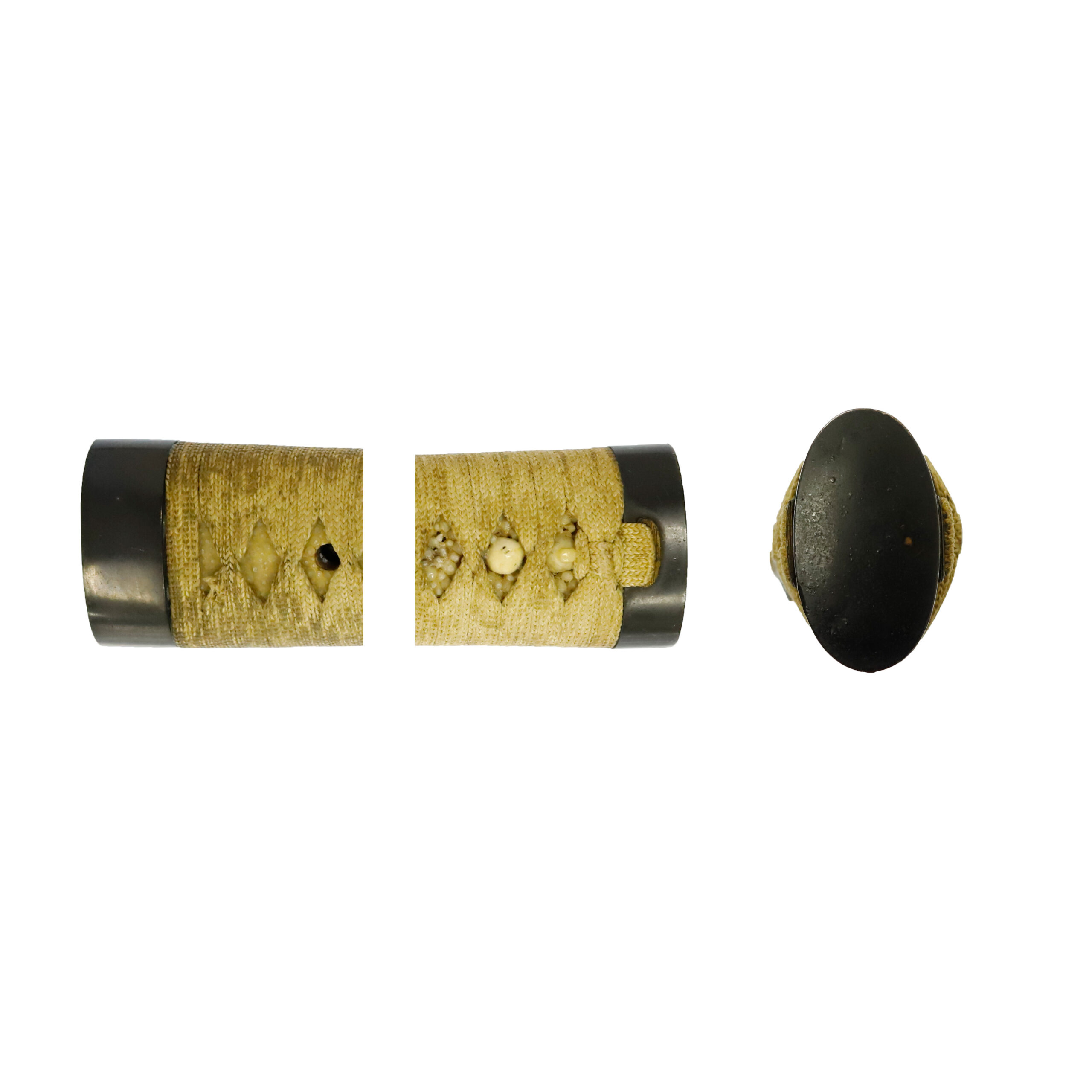
Tsuka and Menuki:Tsuka is the handle of the Japanese sword and Menuki is its decoration.
The Hechima (ヘチマ, loofah) or the Hisago (瓢, gourd-generally called Hyoutan in Japanese) is the motif of this Menuki. Loofas are climbing plants. Its fruit is elongated and shaped like a large cucumber. Vines have a strong vitality and a habit of growing vines without interruption. This plant represents longevity and connection. Therefore, this vegetable has been considered very auspicious. Since ancient times, Japanese people have appreciated this plant design as an auspicious motif. For example, a Hisago is written as “瓢,” which can also be read as “Hyou.” Therefore, three Hisagos were considered the San-Byoushi (三拍子, triple time, 拍子 can also be pronounced as Hyoushi). And people compared six Hisagos to Mubyou Sokusai (無病息災, be in perfect health). It is because the word “病 (Byou)” has the same pronunciation as “瓢 (it also can be read as Byou).” Also, the Hisago pattern represents success in business and the prosperity of descendants as this plant produces lots of fruits. These meanings tell you how Japanese people love this design based on its acting superstitiously for good luck.

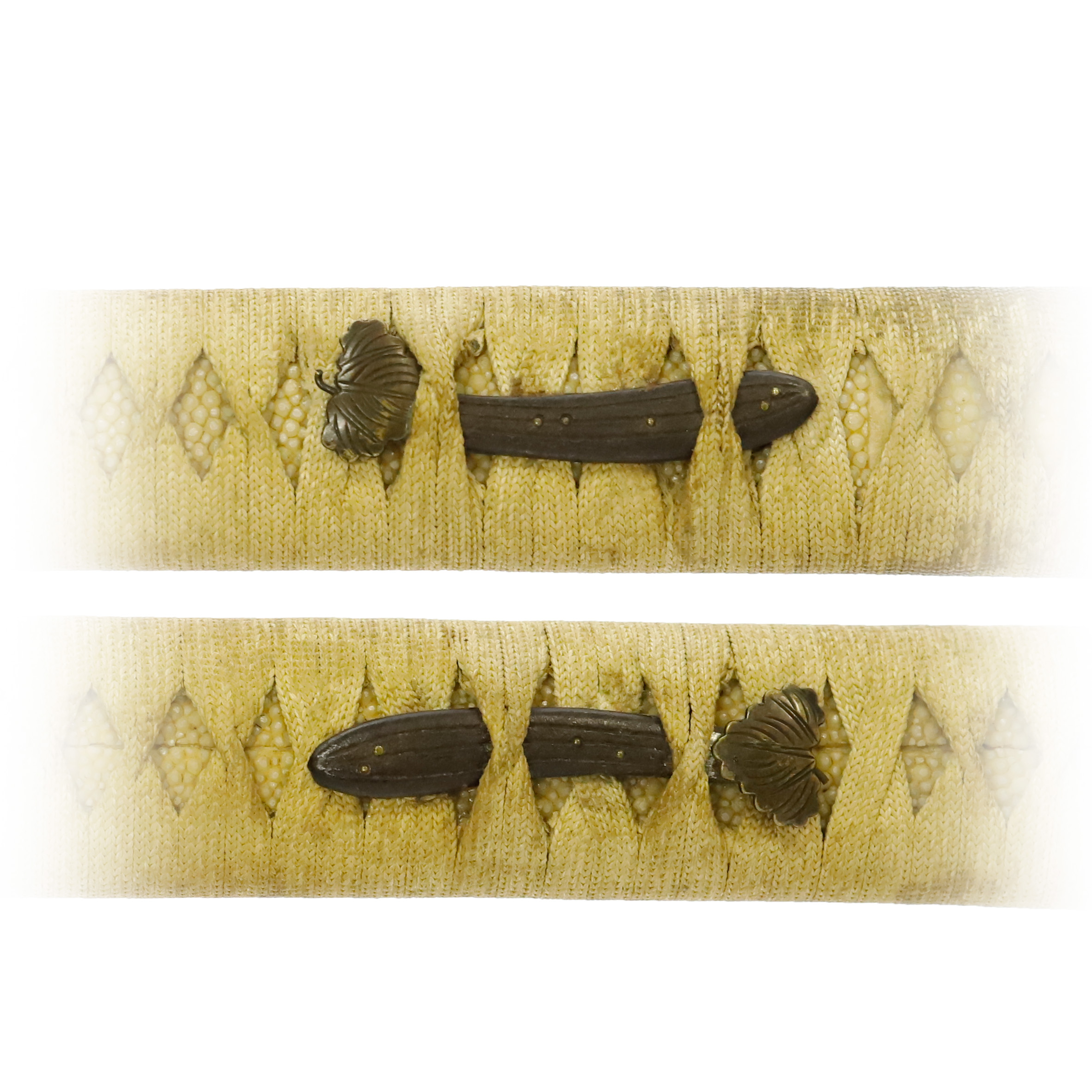
Tsuba and Habaki:Tsuba is the handguard for the Japanese Sword and Habaki is the equipment to make the blade not touch its scabbard inside. It prevents the blade from getting rusty and chipped.
This Tsuba’s Mimi (耳, edge) is framed with a thin silvery plate. This decorative process is called the Fukurin (覆輪), and one of its purposes is to add beauty to works. In addition, it has practicality, such as preventing the wear of the edge part. Also, it prevents wear and tear on the Kimono if the edge damages it by touching the cloth.
The Botan (牡丹, peony) flowers are engraved on this Tsuba. Peony represents happiness, wealth, nobleness, and gorgeousness. This flower pattern has been treated as a kind of good-omen motif; people regarded it as a rich harvest sign. Peony is called the Botan in Japanese. When we write this flower’s name in Japanese, its second letter means mountain hermit medicine that would give us eternal youth. Based on the meaning of this letter, the peony pattern symbolizes eternal youth and longevity.
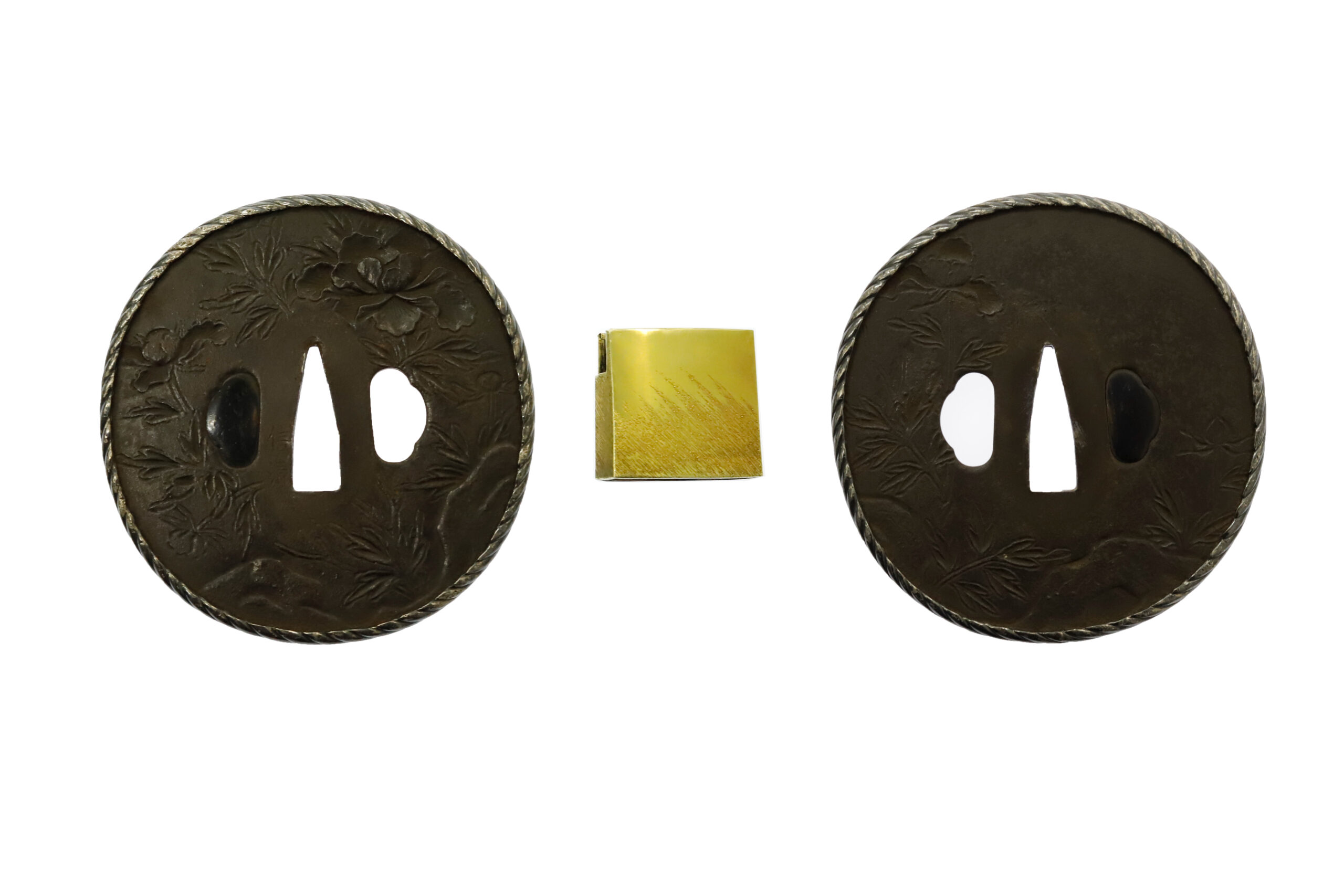
Saya: Saya is the scabbard for the Japanese sword.
*Please keep in mind that there are a few aging spots on this Saya. If you like to know the detailed condition, please feel free to contact us.
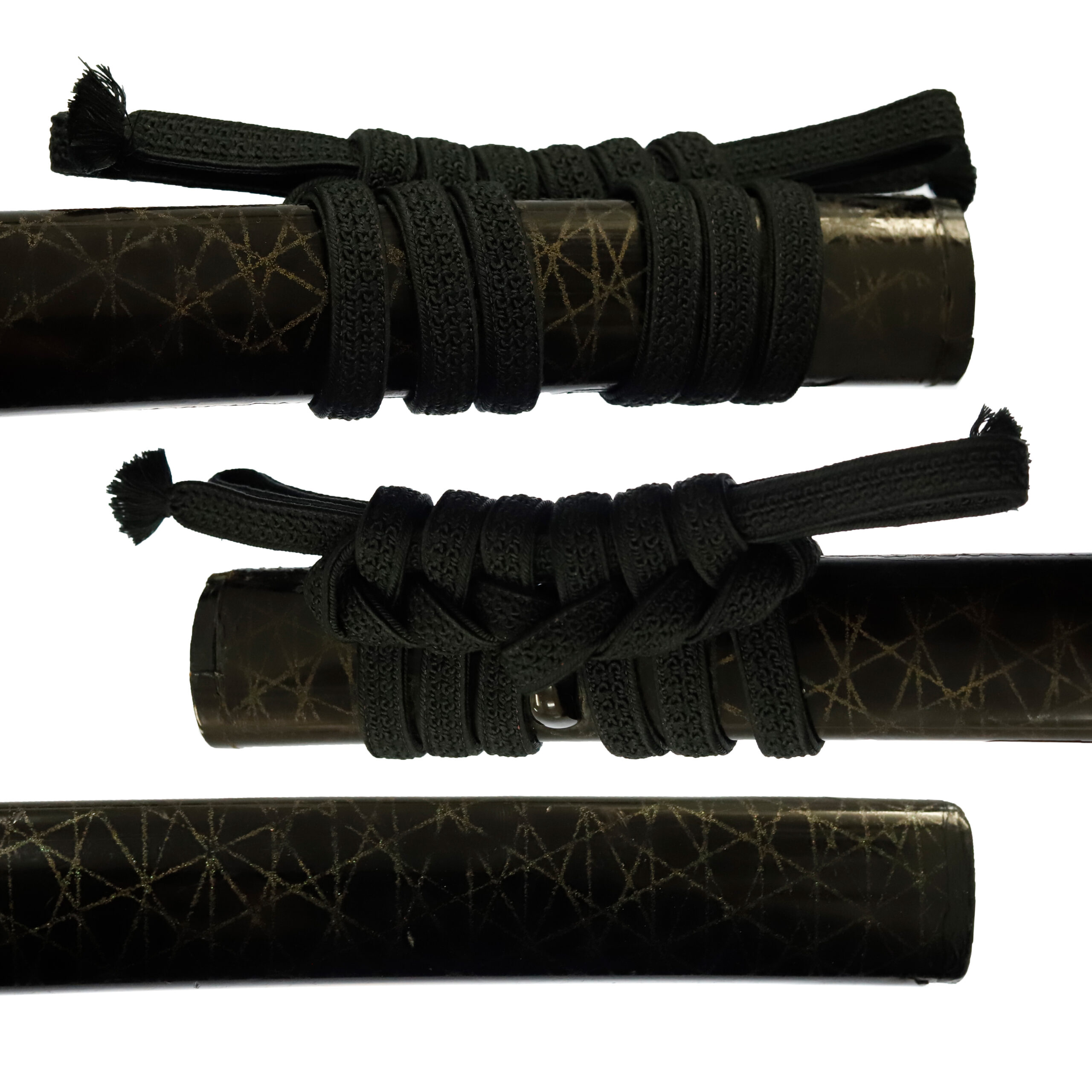
Authentication Paper:NBTHK TOKUBETSU Hozon Certificate for the blade (No. 1012183)
NBTHK, also known as Nihon Bijutsu Touken Hozon Kyokai (the Society for the Preservation of the Japan Art Sword), is one of the oldest Japanese sword appraising organizations in modern-day Japan. They authenticated the blade on March 23th in the 28th year of Heisei (2016). They appraised it as Tokubetsu Hozon Touken, the blade especially worth preserving for Japanese society. The purchaser will receive this original certificate as well. We can also translate what is written into English and make a PDF file for your record if you request.
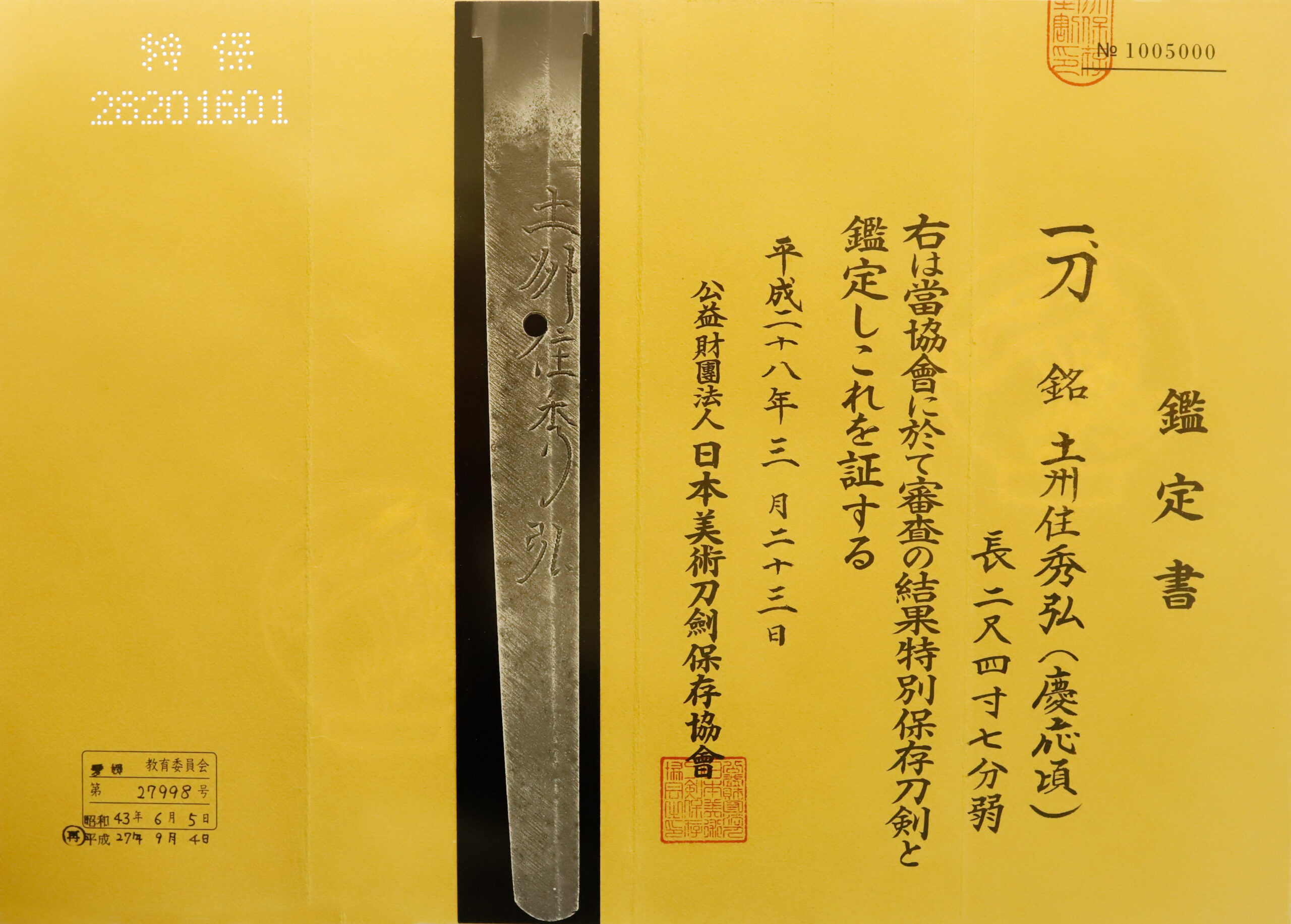
Registration Number : Ehime 27998
The Board of Education in Ehime prefecture issued a registration paper for this sword . It is called Jyu Token Rui Torokusho(銃刀剣類登録証). Bunkacho(The Agency for Cultural Affairs) acknowledges a Japanese sword with this paper as a work of art.
The sword needs to be traditionally hand-forged and made of Tamahagane carbon steel to be registered in the system. With this paper, its owner in Japan can legally own an authentic Japanese sword. Based on this registration number, we will apply for its export permit.
This paper will need to be returned to the board of education when the sword is being shipped abroad, but you can receive a copy of it. An English translation of this registration paper is available on request.
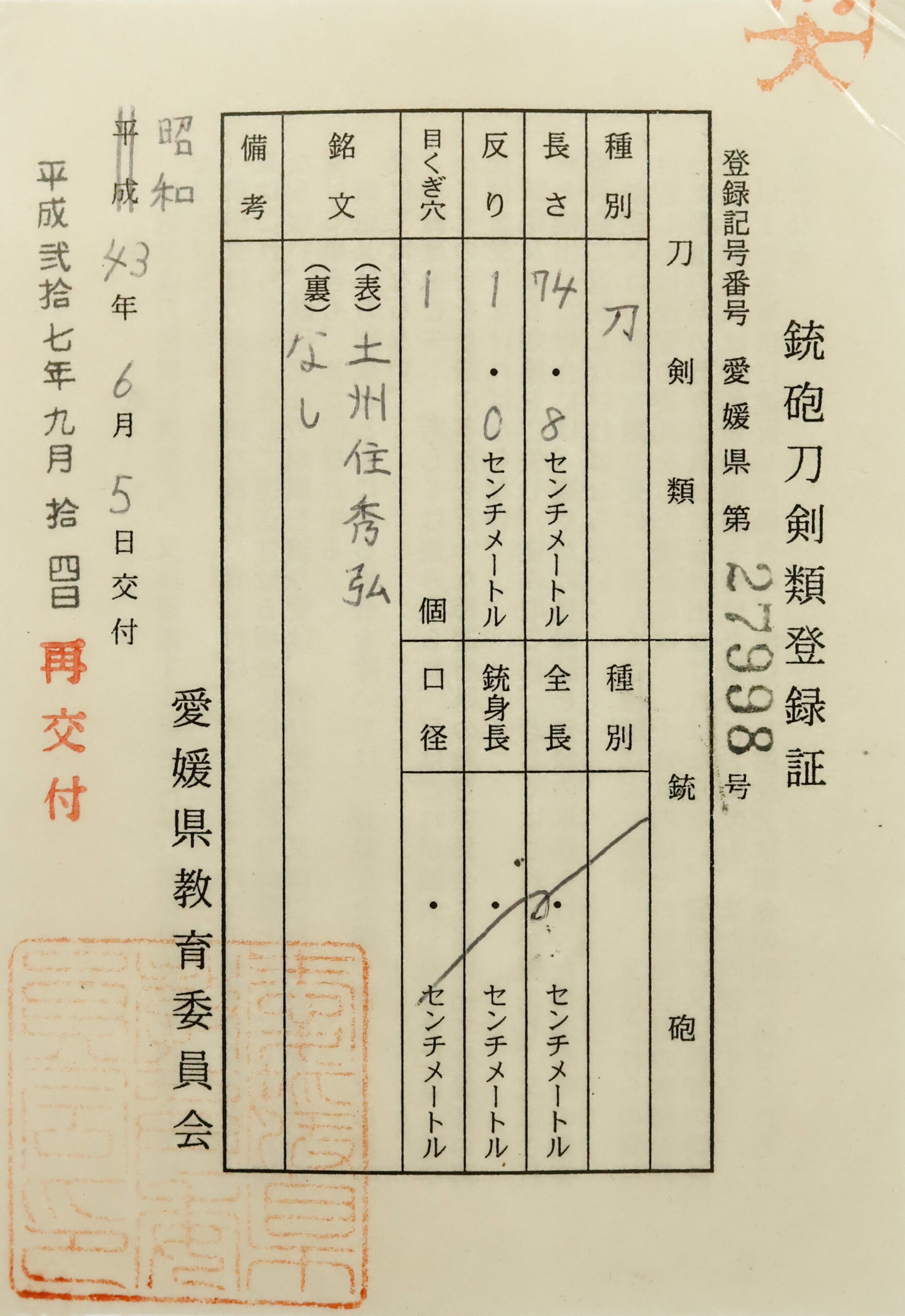

—————————————————————–
【About us】
Samurai Museum is located in Tokyo, Japan, exhibiting antique artifacts related to the Samurai history. Samurai Museum Shop is the place for those who are interested in Japanese culture and craftsmanship. We deal with antique Samurai swords/armor, traditional crafts made in Japan and so on.
【Japanese Sword& Export Process】
The Japanese swords we deal with are hand-forged edged swords made in Japan. It was made from the traditional carbon steel called TAMAHAGANE(玉鋼). Samurai Museum is familiar with the proper legal procedure for an antique/ authentic Japanese sword to be exported from Japan. We have sent more than 700 Japanese swords for the past few years (~2024) to amazing owners who appreciate its historical value.
Each Japanese sword is registered under the Agency for Cultural Affairs and the Board of Education in Japan. They issue a registration paper for each Japanese sword for its owner in Japan to legally possess it. The Japanese sword with its registration paper means it was traditionally hand-forged in Japan.
To legally export the sword from Japan to other countries, we will have to apply for its permit to the Agency for Cultural Affairs(Bunkacho) and return the original registration paper to the Board of Education. It normally takes around 2-4 weeks to receive this permit after submitting required documents. And we would like you to expect at least 1-1.5 months for your order to arrive at your given address after you ordered. For more detailed info, please click here.
It is allowed for residents in Japan to own authentic Japanese swords without a special license as long as they come with registration papers. Please feel free to contact us if you are a resident of Japan, whether temporarily or permanently. We will also assist you when you leave Japan and need to obtain the export permit.
【Payment Method】
We accept payment through Stripe (Credit card), PayPal, Apple Pay or ChromePay, all of which are secure payment methods. Also, you don’t need to make an account on Stripe for the checkout. If you prefer other payment method, please contact us. After confirming your payment, we will apply for an export permit. You may either pay in JPY, USD, AUD, CAD,EUR CHF or GBP. The price is set in Japanese Yen. Prices in other currencies are automatically calculated based on the latest exchange rate.

* If the amount is above 1 million JPY, Stripe or wire transfer will be the only options for payment.
【Shipping】
We have shipped authentic Japanese swords to the USA, UK, Canada, Mexico, Germany, France, Hong Kong, Finland and Australia. If you don’t live in these countries and like to order, please contact us first before making a purchase. We offer Free International Shipping as long as we can send antique Japanese swords by EMS.
We normally ship by EMS(Express Mail Service) provided by Japan Post. We will send you a tracking number for your order as soon as we hand it to the post office. We will put 100 % insurance on the shipping document without any extra charge. Based on the total amount, there might be a duty tax or other fee for you to pay, depending on the countries. We use package cushioning to protect the item and put it in a PVC pipe, which is one of the most secure packages because of its durability.
It will normally takes 5-14 days for the item to arrive at your given address after we dispatch it. Time of delivery is estimated as accurately as possible by the carrier but does not take into account any delays beyond our control such as by inclement weather, post office holiday seasons.
* If you live in Australia and like to purchase an authentic Japanese sword, please click here to know the detail.

【Review】
Here is one of the reviews we received from a customer who purchased an authentic Japanese sword from us. For more reviews, please click here.
“My experience overall with the whole process was wonderful. I had many questions about the history and process to purchase these treasures. All my questions were answered very timely and complete. The staff is very knowledgeable and very well versed if any questions do arise.”
【How to make sure the condition】
Please keep in mind that what you are going to purchase is an antique item. We uploaded high resolution photos for you to check its condition thoroughly. If you like to see more photos with different angles, please feel free to contact us. We will be happy to send them to you so that you can make informed decision. It is essential for us to know that you are happy with your choice of a sword. and we are prepared to use the best of our ability to serve you.
【How To Contact Us】
Please contact us through email, Facebook Messenger or Live Chat if you have any questions. You can find each icon on the right side of the website. Please click one of them to reach us. We will reply to you within 1-2 business days.
【The Art of Nihonto (Japanese Sword)】
Samurai’s history is a profound, eloquent legacy of ancient Japanese warriors in which millions of people worldwide are being fascinated. If you like to find out the art of Nihonto, please click here.
【A Guide to Japanese Sword Maintenance】
After acquiring an genuine Japanese sword, it is also important to know how to take good care of it. Here is the special video for you. Mr. Paul Martin, Japanese sword expert, shows you how to give proper maintenance to your sword. By mastering how to clean the Japanese sword, its aesthetic beauty will last forever.
When you purchase a Japanese sword from us, you can get a Free Japanese sword maintenance kit. It comes with four tools(Choji Oil, Uchiko Whetstone Powder, Peg remover, Oil Applicator). By watching the video instruction above , you can enjoy learning how to maintain your Japanese sword while appreciating it. If you have any difficulty assembling the sword or cleaning the blade, you can feel free to contact us.


MORE ANTIQUE JAPANESE SWORD FOR SALE
SWORDS WITHOUT CERTIFICATES FOR SALE
LEARN JAPANESE SWORD TERMINOLOGY
Thank you for reading all the information on the page. If you have any difficulty choosing the right Japanese sword for you, we will be more than happy to help you find the one that speaks to you the most. Please feel free to contact us.
